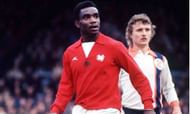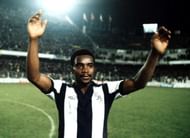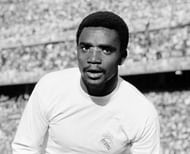"Black players lack bottle." This was the response of the majority of managers in the first two divisions of English football back in the 1970s. This era saw the rise of National Front and the British Movement which gave extremist right-wing groups a license to spread hatred based on race.
At those times, a black player was subjected to new heights of racism which made it tough for the youngsters to take up the game on a professional level.
One man rose to this challenge and changed the face of football in England for the future of black footballers. He was an idol to the next generation of black footballers like John Barnes, Paul Ince and much much more. He was the first black player to play for England at any level and also the first British player to ply his trade for one of the biggest clubs in the world - Real Madrid.
This unsung hero of the game was Laurie Cunningham who gave it back to the lacking bottle comment by saying, “How come black skin lacks courage when Muhammad Ali is the champion of the world?”
Laurie loved dancing and his style of play reflected that on a football field. Cunningham's style of play was one of poise and finesse as he blitzed past defences with his burst of pace.
His story, one of inspiration and ultimate professional heights of success, was brought to a sudden end at the age of 33. The story of Laurie Cunningham needs to be told to this generation to make them aware of the legend of a footballer who, against all odds, became one of the best in the world.
The beginning at Leyton Orient
Born on March 8, 1956, in Archway, London, Cunningham was rejected by Arsenal when he was just 16. His father was a retired Jamaican jockey and raised Laurie in one of the poorest areas of London.
He then joined Leyton Orient in 1974 with his first day at the club being an interesting tale. Manager George Petchey had told Laurie to report the next day for training at Orient. When he didn't arrive at the decided time, the club sent an employee to look for the youngster.
He was sleeping at his home and then arrived casually at the ground taking a stroll. Petchey knew at that exact time that Laurie was either a lunatic or a gifted individual. The club threatened to fine him £1 for every time he would come late. Laurie, being a brilliant dancer, entered in dance competitions to win the money required for paying fines.
During his time with Orient, Laurie had received an offer from US ensemble The Dance Theatre of Harlem for ballet dancing. He thought seriously about joining the world famous group but Petchey convinced him to carry on playing football.
His best game for Orient came against Chelsea when he single-handedly helped his side beat the Blues whose supporters were racially abusing Laurie every time he touched the ball. He later joined West Bromwich Albion for a fee of £100,000 which helped keep the East London club from going bankrupt.
Petchey revealed that he did not want to sell Laurie but had no other option than listening to the club's chairman.
Laurie's rise with the Baggies and his fight with racism
Under Ron Atkinson, Laurie flourished as the duo helped West Bromwich Albion establish a free flowing style at the Hawthorns. The trio of Laurie Cunningham, Cyrille Regis and Brendan Batson became a household name in England as three black players in one team was a rarity then.
They came to be known as "The Three Degrees" - after the US soul-singing girl band with the same name.
Laurie scored 21 goals in three seasons with the Baggies as he helped them reach the semis of the FA Cup and also the UEFA Cup. In one memorable game, Laurie single handedly destroyed Manchester United as West Brom won the game 5-3 with the forward scoring a sensational solo goal.
His performances saw him getting selected for the England U21 squad and he justified that by scoring the winner on his debut against Scotland. Laurie became the first black player to represent England at this level.
In a European game against Valencia, Cunningham caught the attention of Real Madrid who became instant admirers of his dazzling football. Valencia fans gave him a standing ovation as Atkinson reflected on Laurie's performance by saying, "It reached the point that even Valencia's fans were willing him to run at the defender, he was that good."
His teammate and legendary manager Vicente del Bosque said, "Madrid viewed him as one of the most distinguished footballers in Europe." At that time, Spanish clubs were allowed only two foreigners in the first team squad.
Laurie became one of them in 1979 as he also became the first British player to play for Real Madrid. In a sense, he was their first ever Galactico.
But along with his rise at West Brom, Laurie was a victim of immense racism in almost all of his away games. They called him "C**n, Zulu" and threw bananas at him which he gave it to the linesman without even reacting to the crowd, such was his uber cool demeanour.
Laurie's flashy style of play made him an easy target for England's overt racism of that time.
In one such game against Millwall, Laurie was subjected to disgusting racial slurs whenever he touched the ball. The home supporters made monkey noises towards Laurie and flapped their arms shouting "C**n, C**n, C**n".
Laurie replied with a stunning solo goal and celebrated in front of the Millwall supporters raising his fist signifying the Black salute. That incident started to change the way England looked at its black footballers and etched Cunningham's name in the history as an epitome of strength and defiance.
Life at Real Madrid
Laurie Cunningham became the second most expensive player in July 1979 when Real Madrid signed him up for £995,000. "He must be the best attacker in the world considering how much Madrid have paid for him," Alfredo Di Stéfano said on Laurie's arrival at the Bernabeu.
He had a dream first season with Los Blancos as Laurie won the league and the Copa del Rey to announce himself on the biggest stage.
The Englishman’s best moment in a white shirt came in a match against FC Barcelona at Camp Nou in 1980, where he absolutely tormented the Catalan defence. The hosts had absolutely no answer for Laurie as he made a mockery of the fullback on that day, Rafa Zuviria.
He received a standing ovation from the knowledgeable Camp Nou crowd as Marca's headline read on the next day - "Cunningham, the conquistador," which translated to Cunningham, the Conqueror. A few years ago, on his 25th death anniversary, AS ran a special story on Laurie titled - "The man who ran riot at Camp Nou."
Till this day, he remains the last Real Madrid player to receive a standing ovation at Camp Nou.
Laurie's stint in Spain was sadly not remembered for his breathtaking first season but for the succeeding seasons he stayed at the Bernabeu. In the next three years, he suffered a broken toe, a serious thigh injury and three surgeries on his left knee.
An image of Laurie in a nightclub with plaster on his toe started making the rounds in newspapers which led to a huge controversy in Madrid. He was fined by the club for his reported laid back attitude which was regarded by many as an unnecessary campaign by the media.
A flurry of injuries saw Cunningham never regain that famed pace of his which led to a total downfall of his career.
Along with that, his long-time girlfriend Nicky Brown, whom he met at a nightclub during his time with Leyton Orient left Spain after getting hounded by the press. People close to Laurie said that Nicky's departure broke Laurie as she had always been with him since he was 15.
The duo were living together without a marriage which was considered a big thing in that time's Catholic Spain.
Despite a brilliant first season, Laurie could not achieve the heights that his talent deserved. Real Madrid shipped him to Manchester United on loan but Laurie's diminished might and injury concerns saw him failing at Old Trafford.
He was soon sold to Sporting Gijon where also he could not influence much. His wife Sylvia Sendin-Soria reflected on his tough times after leaving Real Madrid, “There were days when you saw him low. When a man has been so high and then has to settle for less it shows.”
After Gijon, Laurie played for Marseille, Leicester City, Rayo Vallecano, Charleroi and Wimbledon. At Wimbledon, he won the FA Cup causing an upset against Liverpool at Wembley. With Rayo Vallecano, Laurie helped the Madrid side promote to the first division where he is still considered as the club's central figure to rise from racism.
In July 1989, Laurie crashed his car against a flat tired car on the side of the road which turned out to be a fatal one for the player, who was once called as the Black Pearl by the Spanish media. The pace which made Laurie Cunningham reach the heights of Santiago Bernabeu killed him in a sad twist of fate.
The bottom line
Laurie Cunningham was an exceptional talent. He was a player ahead of its era as Laurie had skills which no one would have even imagined in his time. The Cunningham became a famous move where he took corners from the outside of his boot. What audacity! He was a crowd puller and justified the huge fees which clubs paid to secure his services.
More importantly than that, Laurie became a voice for the black footballers who received a lot of abuse. He was the catalyst that brought a sense of belief and courage for the next generation to pursue their dreams. The Englishman played as a true blue Brazilian for whom Vicente Del Bosque once said that he was as good as Cristiano Ronaldo.
Sid Lowe's article on him had a beautiful line - "Madrid were all fight; Laurie was the fantasy." Despite all that he achieved and all that he didn't, Laurie would always remain an unsung hero of the game who broke all barriers in becoming a superstar.




